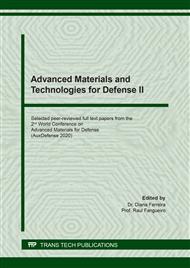[1]
J. Dani, K. Kanny, and P. K, A Review on Research and Development of Green Composites From Plant Protein-Based Polymers,, Polym. Compos., vol. 38, no. 8, p.1504–1518, (2017).
DOI: 10.1002/pc.23718
Google Scholar
[2]
A.-M. Ahmad Y and S. Polat, Review of the Main Factors Controlling the Fracture Toughness and Impact Strength Properties of Natural Composites,, Mater. Res. Express, vol. 6, no. 2, (2018).
DOI: 10.1088/2053-1591/aaec28
Google Scholar
[3]
L.S. Sutherland, A review of impact testing on marine composite materials: Part I - Marine impacts on marine composites,, Compos. Struct., vol. 188, no. November 2017, p.197–208, (2018).
DOI: 10.1016/j.compstruct.2017.12.073
Google Scholar
[4]
J. Reiner, J. P. Torres, M. Veidt, and M. Heitzmann, Experimental and numerical analysis of drop-weight low-velocity impact tests on hybrid titanium composite laminates,, J. Compos. Mater., vol. 50, no. 26, p.3605–3617, (2016).
DOI: 10.1177/0021998315624002
Google Scholar
[5]
A. Riccio et al., Impact behaviour of omega stiffened composite panels,, Prog. Aerosp. Sci., vol. 81, p.41–48, (2016).
Google Scholar
[6]
S. Safri, M. Sultan, N. Yidris, and F. Mustapha, Low Velocity and High Velocity Impact Test on Composite Materials–A review,, Int. J. Eng. Sci, vol. 3, no. 9, p.50–60, (2014).
Google Scholar
[7]
J. J. Andrew, S. M. Srinivasan, A. Arockiarajan, and H. N. Dhakal, Parameters influencing the impact response of fiber-reinforced polymer matrix composite materials: A critical review,, Compos. Struct., vol. 224, no. December 2018, (2019).
DOI: 10.1016/j.compstruct.2019.111007
Google Scholar
[8]
R. Tiberkak, M. Bachene, S. Rechak, and B. Necib, Damage prediction in composite plates subjected to low velocity impact,, Compos. Struct., vol. 83, no. 1, p.73–82, (2008).
DOI: 10.1016/j.compstruct.2007.03.007
Google Scholar
[9]
J. Modniks, E. Poriķe, J. Andersons, and R. Joffe, Evaluation of the apparent interfacial shear strength in short-flax-fiber/PP composites,, Mech. Compos. Mater., vol. 48, no. 5, p.571–578, (2012).
DOI: 10.1007/s11029-012-9301-7
Google Scholar
[10]
M. I. M. Kandar and H. M. Akil, Application of Design of Experiment (DoE) for Parameters Optimization in Compression Moulding for Flax Reinforced Biocomposites,, Procedia Chem., vol. 19, p.433–440, (2016).
DOI: 10.1016/j.proche.2016.03.035
Google Scholar
[11]
R. Muthuraj, M. Misra, F. Defersha, and A. K. Mohanty, Influence of processing parameters on the impact strength of biocomposites: A statistical approach,, Compos. Part A Appl. Sci. Manuf., vol. 83, p.120–129, (2016).
DOI: 10.1016/j.compositesa.2015.09.003
Google Scholar
[12]
R. M. Johnson, N. Tucker, and S. Barnes, Impact performance of Miscanthus/Novamont Mater-Bi® biocomposites,, Polym. Test., vol. 22, no. 2, p.209–215, (2003).
DOI: 10.1016/s0142-9418(02)00084-3
Google Scholar
[13]
M. Johnson, N. Tucker, S. Barnes, and K. Kirwan, Improvement of the impact performance of a starch based biopolymer via the incorporation of Miscanthus giganteus fibres,, Ind. Crops Prod., vol. 22, no. 3, p.175–186, (2005).
DOI: 10.1016/j.indcrop.2004.08.004
Google Scholar
[14]
M. Morreale, R. Scaffaro, A. Maio, and F. P. La Mantia, Mechanical behaviour of Mater-Bi®/wood flour composites: A statistical approach,, Compos. Part A Appl. Sci. Manuf., vol. 39, no. 9, p.1537–1546, (2008).
DOI: 10.1016/j.compositesa.2008.05.015
Google Scholar
[15]
K. Kirwan, R. M. Johnson, D. K. Jacobs, G. F. Smith, L. Shepherd, and N. Tucker, Enhancing properties of dissolution compounded Miscanthus giganteus reinforced polymer composite systems. Part 1. Improving flexural rigidity,, Ind. Crops Prod., vol. 26, no. 1, p.14–27, (2007).
DOI: 10.1016/j.indcrop.2006.12.013
Google Scholar
[16]
S. Z. H. Shah, S. Karuppanan, P. S. M. Megat-Yusoff, and Z. Sajid, Impact resistance and damage tolerance of fiber reinforced composites: A review,, Compos. Struct., vol. 217, no. November 2018, p.100–121, (2019).
DOI: 10.1016/j.compstruct.2019.03.021
Google Scholar
[17]
S.N.A. Safri, M.T.H. Sultan, M. Jawaid, and K. Jayakrishna, Impact behaviour of hybrid composites for structural applications: A review,, Compos. Part B Eng., vol. 133, p.112–121, (2018).
DOI: 10.1016/j.compositesb.2017.09.008
Google Scholar
[18]
S. D. Salman, Z. Leman, M. T. H. Sultan, M. R. Ishak, and F. Cardona, Ballistic impact resistance of plain woven kenaf/aramid reinforced polyvinyl butyral laminated hybrid composite,, BioResources, vol. 11, no. 3, p.7282–7295, (2016).
DOI: 10.15376/biores.11.3.7282-7295
Google Scholar
[19]
K. L. Pickering, M. G. A. Efendy, and T. M. Le, A review of recent developments in natural fibre composites and their mechanical performance,, Compos. Part A Appl. Sci. Manuf., vol. 83, p.98–112, (2016).
DOI: 10.1016/j.compositesa.2015.08.038
Google Scholar
[20]
A. P. Johari, S. Mohanty, S. K. Kurmvanshi, and S. K. Nayak, Influence of Different Treated Cellulose Fibers on the Mechanical and Thermal Properties of Poly(lactic acid),, ACS Sustain. Chem. Eng., vol. 4, no. 3, p.1619–1629, (2016).
DOI: 10.1021/acssuschemeng.5b01563
Google Scholar
[21]
A. U. Birnin-yauri, N. A. Ibrahim, N. Zainuddin, K. Abdan, Y. Y. Then, and B. W. Chieng, Effect of maleic anhydride-modified poly(lactic acid) on the properties of its hybrid fiber biocomposites,, Polymers (Basel)., vol. 9, no. 5, p.1–16, (2017).
DOI: 10.3390/polym9050165
Google Scholar
[22]
S. D. Salman, Z. Leman, M. T. H. Sultan, M. R. Ishak, and F. Cardona, The effects of orientation on the mechanical and morphological properties of woven kenaf-reinforced poly vinyl butyral film,, BioResources, vol. 11, no. 1, p.1176–1188, (2016).
DOI: 10.15376/biores.11.1.1176-1188
Google Scholar
[23]
U. Farooq and P. Myler, Finite element simulation of damage and failure predictions of relatively thick carbon fibre-reinforced laminated composite panels subjected to flat and round noses low velocity drop-weight impact,, Thin-Walled Struct., vol. 104, p.82–105, (2016).
DOI: 10.1016/j.tws.2016.03.011
Google Scholar


